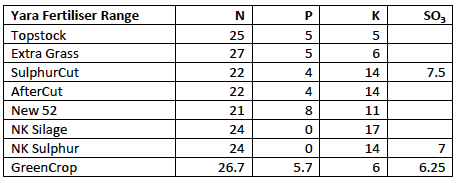Read the latest QNM news
Grassland Management Guidelines
This is a summary of some useful guidelines for grassland management. There are some Key Resources that you should have in the farm office for easy reference which are given at the end.
Reseeding
1. Soil sample before any reseeding – (get someone else to do this if you are not prepared to take 25 core samples in a W across the field – 7.5 cm for grass and 15 cm for arable fields). The basic soil test covers pH, P, K and Mg. A more comprehensive soil analysis with trace minerals as well as organic matter will be a good investment at reseeding. Sample 2 months after any fertiliser/slurry has been applied in late autumn or early spring.
2. Check for any drainage or compaction issues and correct with ploughing and/or sub-soiling where necessary.
3. Correct low pH with lime before reseeding and correct P and K status to soil index 2
4. Choose seed mixture based on target use i.e. grazing or silage and make use of the new hybrid tetraploid and diploid varieties available which have a proven yield and nutritional benefit. Plant breeders are claiming a 2% yield increase per year so a 10% yield increase for new varieties on top of the normal benefits of reseeding and replacing weeds.
5. Sow at the recommended seed rate – anything else is false economy. Sow in top 5 cm of fine seed bed and roll to conserve moisture.
6. It is better to graze lightly with sheep or calves rather than cut first time round, to encourage tillering.
Renovating
- Slot seeding or direct drilling can work as long as there are no underlying soil nutrient problems.
- Overseeding works well for clover in late summer at 1.5 to 2 kg/acre.
- Oversow grass/clover mixtures at 8 – 10 kg/acre.
- Graze sward down to 3 – 4 cm and harrow until 25% bare soil or sow just after a silage cut.
- Flat roll or graze with stock to tread the seed in, then rest for 4 weeks.
Weed control
Weeds can be a sign of poor soil fertility, compaction and over or under grazing. Dock seeds survive in slurry and can lay dormant for 70 years! Chickweed may be a problem in reseeds (sheep do a good job of grazing out) but docks and thistles are the usual problem weeds on dairy farms. Spray with herbicide e.g. Doxstar or Pastor before they get established and top to prevent seeding.
Forefront or Pharaoh are very effective as an autumn treatment on hard to control weeds such as broadleaved and curled docks, creeping and spear thistles, nettles, dandelion and buttercup. Sales of these two products were suspended in 2008 after incidents involving alleged damage to some sensitive crops were reported in the UK. This was possibly due to manure that had come from farm animals or horses fed pasture or conserved forage from grassland previously treated with herbicides containing the active ingredient aminopyralid found in Forefront and Pharaoh. These products have been re-introduced this year in Scotland, Northern Ireland and south west England, but with tight controls to prevent problems with manure management - including restrictions on usage, and a stewardship scheme which makes sure farmers are aware of the implications for subsequent manure management. They can be used on established grassland after the final cut has been taken, provided it is then grazed by cattle or sheep. Any silage, hay or haylage made the following year must stay on the farm and any manure from animals fed this forage must also stay on the farm and be spread on grassland.
Fertiliser
Soil pH is an often neglected area. The target for grassland is 6 and lime is required for soils below this. For soils at pH 5.6 – 5.8 apply lime at 2 t/ha and for soils 5.2 – 5.5 apply lime at 4 t/ha. The effectiveness of lime depends on how finely it is ground and its neutralising value (NV) which can vary depending on source. Most recommendations are based on a NV of 50 – 55. Full recommendations are given in RB 209.
Grass needs nitrogen (N), phosphorus (P) and Potassium (K) to optimise growth. In many areas of the country sulphur (S) is also required. In the UK the convention is to express crop requirements for nutrients and bagged fertiliser content in a different form to the soil analysis. Soil and crop analysis reports usually show the elemental form e.g. mg P/kg or mg K/l. Crop requirements and fertiliser contents are expressed as the oxides e.g. P as phosphate P2O5, K as potash K2O. Magnesium, sodium and sulphur are also expressed in oxide forms (MgO, Na2O and SO3). For conversions of one form to the other see the table at the end of this summary.
Nitrogen is needed to maximise grass dry matter yield and protein content. It is needed throughout the season and a good guideline is 2.5 kg/ha/day (2 units/acre/day).
Phosphorus is needed in much smaller quantities but is essential for early root growth and for the active uptake of other nutrients. Phosphorus availability can be a problem especially in cold and wet conditions and plants often respond better to nitrogen if phosphate is applied as well. A good guideline is N:P2O5 of 6:1 in intensive systems and 2:1 in extensive systems.
Potassium is essential for plant cell function and is taken up in large quantities during rapid growth. Do not apply Potassium to grazing fields in spring as it interferes with magnesium absorption and can cause grass staggers in grazing livestock. It can be put on after May when the risk is reduced. Potassium is effectively recycled through cattle urine but large amounts can be taken off by grass for silage and need to be replaced. Under intensive grazing a guideline of N:K2O of 6:1 can be used.
Sulphur is becoming more important since there is less deposition of sulphate from the atmosphere and deficiency is more apparent especially in the south west and where no FYM/slurry is applied. It is also prone to leaching from the soil along with nitrate.
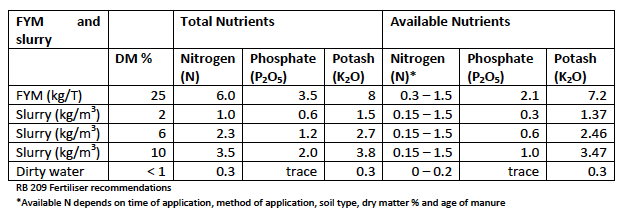
Don’t waste this valuable resource. Plough and incorporate if possible. Avoid applying in winter when run off and leaching is more likely and low soil temperature means soil microbes are inactive. Keep application rates sensible i.e. < 35m3/ha (3150 gallons/acre)
Example - 30m3/ha (2750 galls/acre) dairy slurry (average 6% DM analysis) applied to a medium soil in winter

Soil nitrogen supply (SNS) from previous cropping and inputs

Fertiliser recommendations for silage – kg N/Ha (units/acre)

Use soil analyses, slurry application rates and preferably slurry analysis to work out how much to apply to match grass requirements – refer to RB209.
With FYM/Slurry – 3 cut silage system

Without FYM/Slurry – 3 cut silage system
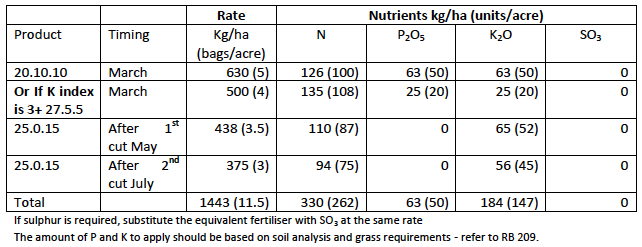
Fertiliser recommendations for grazing – kg N/Ha (units/acre)
Intensive Grazing Systems (> 2 Livestock Units/ha)
With FYM/Slurry
Assuming a 28 day cycle, starting 28 days pre turnout and monthly after that and using the guideline of 2.5 kg/ha/day (2 units/day).

Without FYM/Slurry
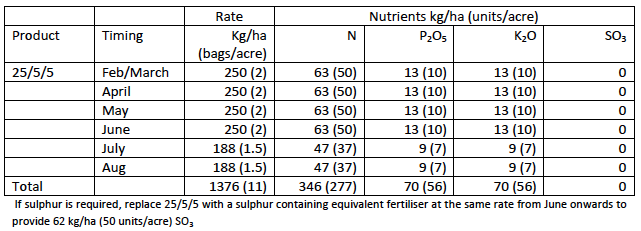
Grazing
The key to getting the best use of grazing is to get the infrastructure in terms of paddock size, tracks and water trough supply right. Then ‘measure it to manage it’, preferably using a plate meter but at the very least by walking it every week and making a note of estimated covers.
Go into paddocks at 2800 kg DM/ha (a standard beer can on end) and come out at 1800 kg DM/ha with high yielding cows and 1400 kg DM/ha (beer can lying down) with low yielders or dry cows. Follow the high yielders with other stock to make sure the residuals are grazed down to 1400 kg DM/ha. The first grazing round of the season is critical for grazing down to 1400 kg DM/ha otherwise quality will be lost for the rest of the season.
Grass growth is very variable and can be 100 kg DM/ha/day at peak and 20 kg/DM/ha/day in a dull, cold week which is why monitoring and flexibility is so important.
At peak growth rate you should be getting round paddocks every 14 to 16 days and will probably need to shut some paddocks up for silage.
At the end of the season it can take 28 days to get round and buffer feed may be needed.
Topping prior to grazing (as long as it doesn’t rain) works well to tidy up paddocks
Key Resources
- The Fertiliser Manual RB209 (www.defra.gov.uk)
- Grass+ Grassland Management Improvement Programme (www.dairyco.org.uk)
- A Guide to Good Silage (www.hcmpw.org.uk)
Conversions
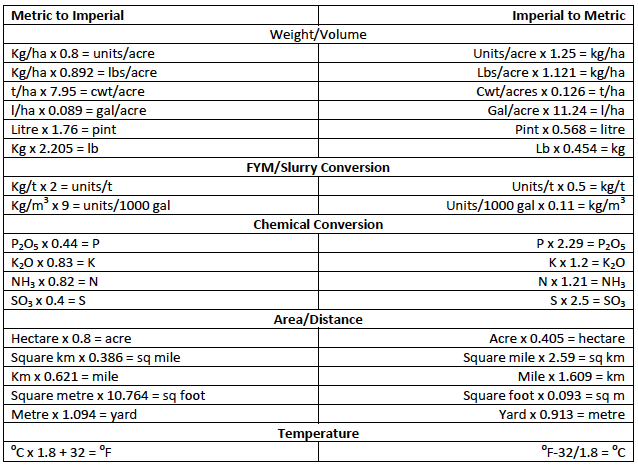
Example fertilisers
